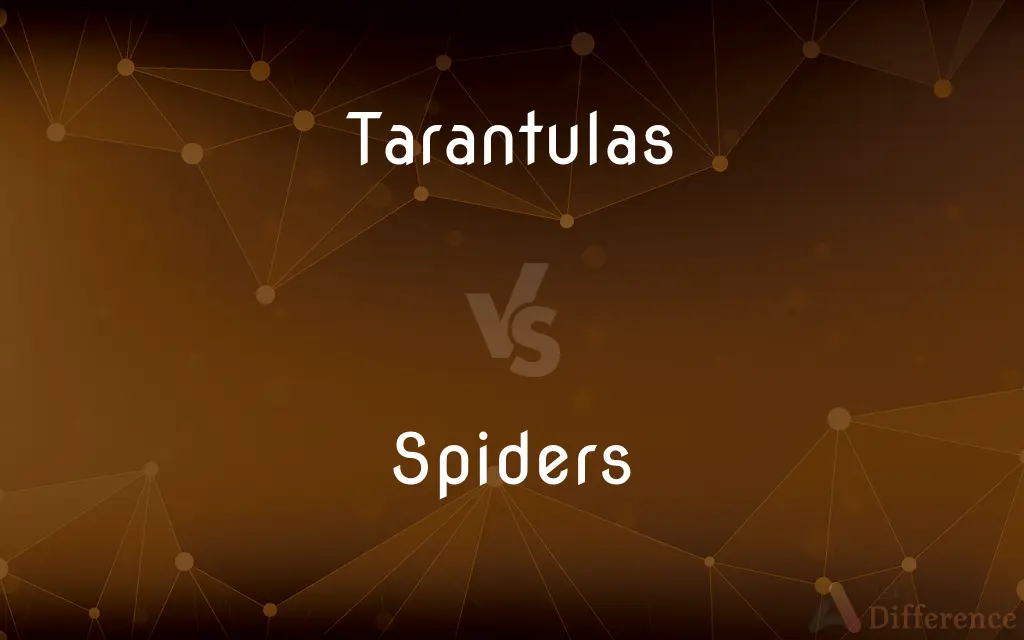Tarantulas vs. Spiders — What's the Difference?
Edited by Tayyaba Rehman — By Maham Liaqat — Published on October 15, 2024
Tarantulas are large, hairy spiders known for their size and docility, ideal for pets, while spiders encompass a diverse group with varying sizes, behaviors, and habitats.

Difference Between Tarantulas and Spiders
Table of Contents
ADVERTISEMENT
Key Differences
Tarantulas belong to the Theraphosidae family, characterized by their large size and hairy bodies, making them distinct within the spider world. They are often kept as pets due to their generally docile nature and fascinating behaviors. On the other hand, spiders encompass a vast array of species across different families, showcasing a wide range of sizes, colors, and habits. This diversity includes everything from the tiny, common house spider to the more venomous species like black widows.
Tarantulas have a specific hunting method, relying on ambush and physical power to subdue their prey, reflecting their more primitive lineage. They lack the speed and agility of some smaller spiders but compensate with strength and their imposing presence. In contrast, spiders employ various hunting strategies, including web-building for trapping insects, active hunting without webs, and even jumping or running down their prey, demonstrating a wide adaptive range to different environments.
Regarding habitat, tarantulas prefer warm, dry, or humid environments, often burrowing underground or residing in natural crevices. Their habitats are primarily in deserts and tropical rainforests. Spiders, however, are found in nearly every part of the world, from the highest mountains to the interiors of homes, adapting to a multitude of environments and climates, showcasing their incredible versatility.
Tarantulas generally have a slower metabolism and can live for several years, with some females reaching ages up to 20 years or more. This longevity is unusual among spiders, many of which have much shorter life spans, sometimes only a single season. The lifespan of spiders varies greatly by species, with some living a few months to a couple of years.
The breeding practices of tarantulas also set them apart. They engage in a delicate mating ritual that can be dangerous for the male if not carefully executed. In contrast, spider mating practices vary widely, with some species exhibiting complex courtship behaviors, while others may be more straightforward or even fatal for the male.
ADVERTISEMENT
Comparison Chart
Size & Appearance
Large and hairy
Varies widely; generally smaller
Habitat
Warm, dry or humid; often burrowing
Diverse: forests, deserts, homes
Hunting Method
Ambush and strength
Webs, jumping, running
Lifespan
Up to 20 years or more
Ranges from months to a few years
Breeding
Delicate, ritualistic
Varies; can be complex or dangerous
Compare with Definitions
Tarantulas
Docile Nature
Despite their size, tarantulas are popular pets due to their calm demeanor.
Spiders
Diverse Group
The spider family includes over 45,000 known species.
Tarantulas
Long Lifespan
Female tarantulas can live for more than 20 years in captivity.
Spiders
Varied Habitats
Spiders can thrive in almost every habitat on Earth.
Tarantulas
Sensitive to Vibration
Tarantulas detect prey through vibrations in the ground.
Spiders
Different Hunting Methods
Some spiders build intricate webs to catch their prey, while others hunt on the ground.
Tarantulas
Large and Hairy
The Goliath birdeater tarantula is one of the largest spiders in the world.
Spiders
Shorter Lifespan
Many spider species live only for a few months.
Tarantulas
Ambush Predators
Tarantulas rely on their strength to subdue prey rather than spinning webs.
Spiders
Complex Mating Rituals
Some spider species perform elaborate dances to attract a mate.
Tarantulas
Any of various large hairy spiders chiefly of the family Theraphosidae, capable of inflicting a bite that is painful but usually not dangerous to humans.
Spiders
Any of numerous arachnids of the order Araneae, having a body divided into a cephalothorax and an abdomen, eight legs, two chelicerae that bear venom glands, and two or more spinnerets that produce the silk used to make nests, cocoons, or webs for trapping insects.
Tarantulas
A large wolf spider (Lycosa tarentula) of southern Europe, once thought to cause tarantism.
Spiders
One that resembles a spider, as in appearance, character, or movement.
Tarantulas
Plural of tarantula
Spiders
Plural of spider
Common Curiosities
Why do some spiders live longer than others?
Lifespan varies by species, depending on factors like metabolism, habitat, and predation risk.
What makes tarantulas different from other spiders?
Tarantulas are distinguished by their large size, hairy bodies, and generally docile nature.
What are spider webs made of?
Spider webs are made of silk proteins produced by the spider’s silk glands.
How do tarantulas defend themselves?
Tarantulas can defend themselves by fleeing, using their hairs to irritate, or biting.
Can all spiders produce silk?
Yes, all spiders have silk-producing glands, but not all use silk to make webs for catching prey.
Are tarantulas dangerous to humans?
Most tarantulas have venom that is mild and not considered dangerous to humans, though their bites can be painful.
How do spiders hunt without webs?
Non-web-building spiders may hunt by ambushing, chasing, or jumping on their prey.
How do spiders sense their prey?
Spiders sense their prey through vibrations and changes in air currents.
How do spiders contribute to the environment?
Spiders play a crucial role in controlling insect populations, acting as natural pest controllers.
What is the largest species of tarantula?
The Goliath birdeater tarantula is considered the largest, by mass and size.
What is the purpose of spider venom?
Spider venom is primarily used to immobilize or kill prey.
What habitats are tarantulas found in?
Tarantulas are typically found in tropical, desert, and sub-tropical environments.
Do all spiders have venom?
Yes, all spiders are venomous, but most are harmless to humans.
Can tarantulas swim?
Tarantulas cannot swim but can survive brief immersion in water.
Are spider silk properties the same across all species?
No, the properties of spider silk can vary greatly among different species, adapted for various uses.
Share Your Discovery

Previous Comparison
Dihydropyridine vs. Nondihydropyridine
Next Comparison
New Zealand Accent vs. Australian AccentAuthor Spotlight
Written by
Maham LiaqatEdited by
Tayyaba RehmanTayyaba Rehman is a distinguished writer, currently serving as a primary contributor to askdifference.com. As a researcher in semantics and etymology, Tayyaba's passion for the complexity of languages and their distinctions has found a perfect home on the platform. Tayyaba delves into the intricacies of language, distinguishing between commonly confused words and phrases, thereby providing clarity for readers worldwide.













































